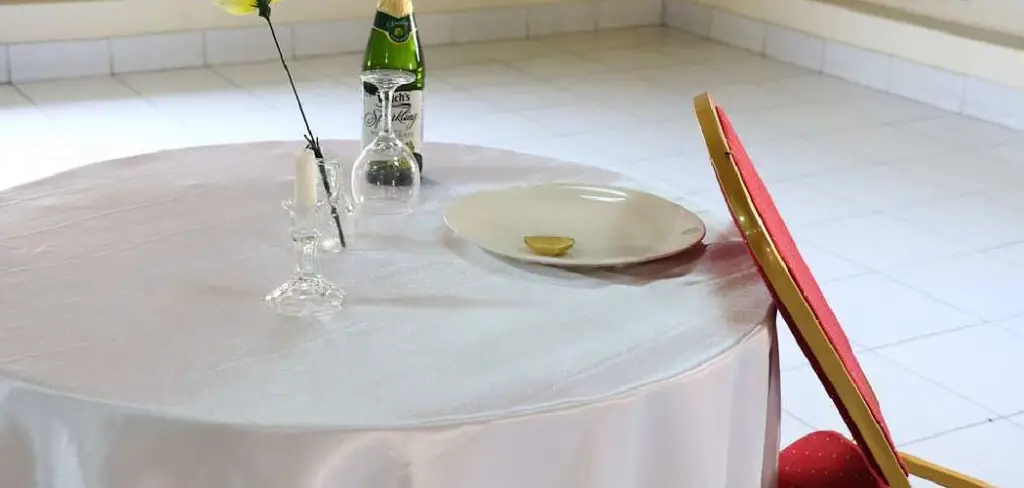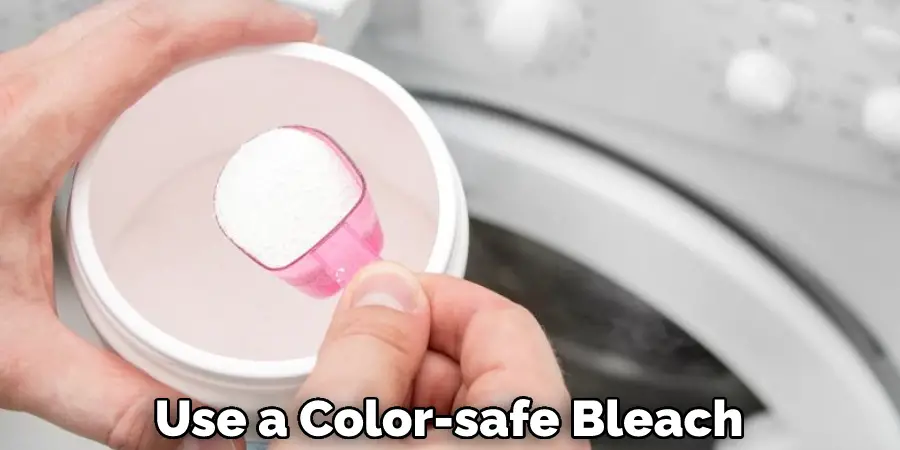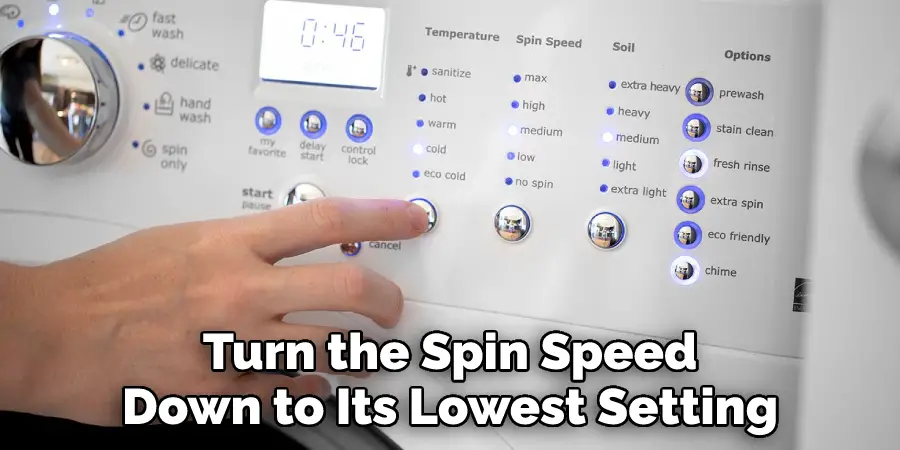If you own a polyester tablecloth, then you know how delicate they can be. You must take special care to ensure that your beautiful piece of fabric lasts for years! In this blog post, we will tell you exactly what to do when it comes time to wash your polyester tablecloths. We’ll talk about how to wash polyester tablecloths and the best temperatures and detergents for various types of fabric, along with tricks and tips on using the right cleaners and machines. No more struggling through stains – learn the optimal way to get rid of them today!

Do Polyester Tablecloths Shrink While Cleaning?
Polyester tablecloths are generally resistant to shrinking when washed. However, it is important to follow the manufacturer’s instructions for washing and drying the cloths in order to ensure that they do not shrink.
In some cases, improper laundering may cause polyester tablecloths to shrink slightly. It is best practice to always use a low-temperature setting on a washing machine when cleaning these clothes, and if possible, air dries them instead of using a clothes dryer.
Taking extra care with temperature settings and drying methods can help prevent any shrinkage from occurring during the laundering process. Although, avoid adding too much detergent or fabric softener, as this can lead to excessive shrinking. Following these simple steps will keep your polyester tablecloths looking great for years to come.
Additionally, if you are ever unsure how to properly care for your tablecloths, consult the manufacturer’s instructions. With a little extra care and attention, your polyester tablecloth will remain vibrant and beautiful for years to come.
10 Methods How to Wash Polyester Tablecloths
1. Machine Wash:
Use a gentle cycle with warm water and mild detergent. Avoid using bleach or fabric softeners. If the tablecloth is heavily soiled, you can pretreat the stained area with laundry detergent or a spot remover. Additionally, use a color-safe bleach if needed.
Though polyester is less likely to shrink, it can still happen if the care instructions are not followed. However, if you tumble dry the tablecloth on low heat or lay it flat to air dry, this will reduce the chances of shrinkage.

2. Hand Wash:
Fill a sink or basin with warm water and mild detergent. Gently agitate the tablecloth in the water and rinse thoroughly. Hang the tablecloth on a line. Do not wring or twist the polyester fabric, as this may cause wrinkles and damage. Allow it to air dry, or use a low heat setting on the dryer. Avoid direct sunlight when drying.
If the tablecloth is heavily soiled, you may need to use a stain remover or spot-treat stubborn stains with a prewash cleaner. To prevent color fading, never use bleach on polyester tablecloths. To remove wrinkles, use a steam iron or steamer on the lowest setting. Avoid pressing too hard, as this may cause permanent creases in the fabric.
3. Soak:
If the tablecloth is heavily soiled, soak it in a solution of warm water and detergent for 30 minutes before washing. Make sure to use a detergent formulated for synthetic fabrics, as other types of detergent may damage the cloth.
After soaking, drain the solution and rinse the polyester tablecloth thoroughly with cold water. However, if the tablecloth is not heavily soiled, you do not need to soak it. Though soaking is optional, it helps to remove stubborn stains and other dirt that may be hard to take off through hand-washing.
4. Pre-Treat Stains:
Treat any stains on the tablecloth with a stain remover or a paste of baking soda and water before washing. Blot excess moisture from the stained area and apply a small amount of pre-wash stain remover. Allow it to soak in before laundering, as usual.
However, it is important to test the stain remover on a small area of fabric before applying it to the entire tablecloth. Although it is tempting to rub the stain, rubbing may cause the stain to spread. Gently blot with a damp cloth. Rinse the area with cold water to remove any remaining residue.

5. Use Cold Water:
If the tablecloth has any colorful designs or prints, use cold water to prevent the colors from fading. Cold water can also help prevent shrinking. Use the gentle or delicate cycle on your washing machine and a mild detergent to avoid any damage occurring to the fabric.
To avoid any damage to the fabric, always use a low spin cycle. Although polyester is a durable fabric, it should still be handled with care. With proper care and maintenance, you can keep your polyester tablecloths looking as good as new for many years!
6. Use a Gentle Detergent:
Avoid using harsh detergents that can damage the fabric. Choose a gentle detergent and test it on a small part of the tablecloth to make sure that it won’t damage the fabric. For best results, use a detergent specifically formulated for handling delicate fabrics. If desired, you may add a fabric softener to the cycle to give the tablecloth a softer finish.
While washing polyester tablecloths, set the machine to a gentle cycle and use only lukewarm water. If your washer has an extra rinse setting, use it to make sure any residual detergent is fully removed. Avoid using hot water, as this can damage the fabric and cause it to shrink.
7. Don’t Overload The Machine:
Wash only a few tablecloths at a time to avoid overloading the machine. Overloading can cause damage to the fabric and stretching of the material. It is also important to ensure that the tablecloths are spread out evenly in the machine before washing.
This will help to prevent any creasing or bunching of the material during the cycle. Finally, use a gentle detergent and cold water to prevent any damage to the polyester fabric. While some polyesters can withstand higher temperatures, it is best to avoid using hot water as this could cause the fabric to shrink or wear out faster.
8. Use the Delicate Cycle:
If your washing machine has a delicate cycle, use it to avoid damaging the tablecloth. The delicate cycle will cause the washer to spin slowly and thus reduce wear and tear on the fabric. If your machine doesn’t have a delicate cycle, be sure to turn the spin speed down to its lowest setting.

Additionally, you may want to use a lingerie bag or pillowcase to contain the tablecloth and keep it from tangling in the washer. Though not necessary, this extra step can protect the fabric even more.
9. Dry on Low Heat:
Polyester tablecloths can be dried in the dryer on low heat. Remove them promptly to avoid wrinkles. It’s advisable to hang them up outside or on a clothesline whenever possible in order to prevent any damage from the heat of the dryer.
It’s also beneficial to add a fabric softener or dryer sheet in the load to help prevent static cling and reduce wrinkles. Once they are dry, press them with an iron and store them in a cool, dry place. Be sure to follow the care instructions on the label of your tablecloth to ensure that it stays in perfect condition.
10. Iron on Low Heat:
If the tablecloth is wrinkled, iron it on low heat. Avoid using a high heat setting, as this can damage the fabric. Use a light steam setting to get rid of wrinkles. However, make sure that the tablecloth is completely dry before using any heat on it.
This will help prevent any shrinkage or burn marks that may occur. Additionally, place a clean cloth over the polyester tablecloth before pressing down on it with the iron. This will help protect it from getting burned or damaged.
Are Polyester Tablecloths Machine Washable?
Yes, polyester tablecloths are machine washable. When washing a polyester tablecloth in the washing machine, it should be washed in cold water with a mild detergent on a gentle cycle. To protect the tablecloth during washing and reduce wear, it is best to turn the cloth inside out before washing.
After washing, it can be dried in the dryer on low heat or air-dried if possible. If you are using chlorine bleach when washing your polyester tablecloth, it is best to opt for a non-chlorine bleach alternative to avoid damage. No matter what type of detergent you use, always make sure to read the instructions on the label and follow the dilution directions when using any product.

Conclusion
After reading this article, you are likely now an expert on washing polyester tablecloths. Regular routine maintenance is important for preventing mold, mildew, and permanent staining. Knowing the correct instructions for caring for your tablecloth will keep it lasting longer and looking better.Now that you have learned about pre-treating, washing, and drying of your tablecloth, you can be confident when laundering your favorite fabric decor item. If you have any other questions about how to wash polyester tablecloths, or if you want to learn more about washing polyester tablecloths, be sure to check out our other blog posts. Thanks for reading!

